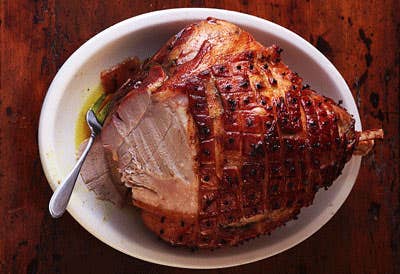
This feastworthy dish, based on a recipe in Pork & Sons by Stéphane Reynaud (Phaidon, 2007), calls for fresh ham, a succulent cut from the pig's hind leg that yields crisp skin and juicy meat. If cooking for a larger crowd, roast a whole fresh ham instead of just the shank end, and double the ingredient quantities for the glaze.
Ingredients
- 1 (12-lb.) fresh ham, cut from the shank end
- 4 cups kosher salt, plus more to taste
- 4 cups brown sugar
- 4 bay leaves
- 1⁄2 cup black peppercorns, crushed
- 1⁄2 tsp. ground white peppercorns
- Cloves, for studding ham
- 1⁄8 tsp. freshly grated nutmeg
- 1⁄8 tsp. ground cinnamon
- 1⁄8 tsp. ground ginger
- 1 tbsp. curry powder
- 1⁄2 cup honey
- 1⁄4 cup red wine
- 1⁄4 cup port
- 3 tbsp. brandy
Instructions
Step 1
Step 2
Step 3
- Using a serrated knife, score the ham by making 1⁄4"-deep, parallel slices about 1" apart all over the meat's surface; turn ham 90° and make perpendicular slices to create a crisscross pattern. Bring salt, sugar, bay leaves, black peppercorns, and 8 cups water to a boil in a 4-qt. saucepan. Transfer brine to a 5-gallon stockpot, add 1 1⁄2 gallons cold water, and submerge ham in brine. Refrigerate ham for 12 hours.
- Heat oven to 350° and set an oven rack in the bottom third of oven. Drain ham, discarding brine, and pat dry with paper towels. Using a paring knife, make 1⁄4"-deep incisions all over surface of ham and stuff a clove into each incision. Season ham lightly with salt, transfer to a rack set inside a large roasting pan, and let ham come to room temperature, about 1 hour.
- Meanwhile, in a 2-qt. saucepan, combine remaining ingredients, bring to a boil, and cook until syrupy, about 5 minutes; set glaze aside. Pour 2 cups water into the roasting pan and roast ham for 1 hour. Remove ham from oven and brush with the glaze. Continue to cook, brushing with the glaze every 30 minutes, until an instant-read thermometer inserted into the deepest part of the ham without touching the bone reads 150°, about 3 hours total. Let ham rest for at least 20 minutes before carving.
Keep Reading
Continue to Next Story










